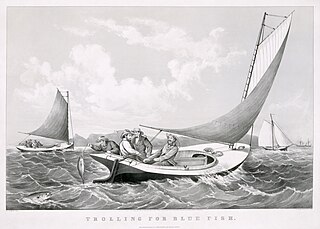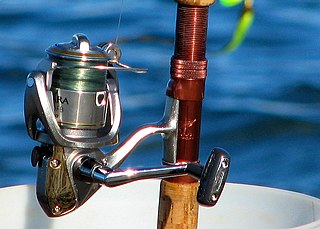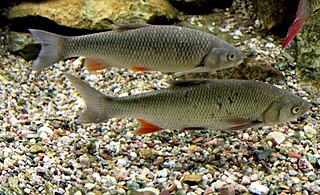
Trolling is a method of fishing where one or more fishing lines, baited with lures or bait fish, are drawn through the water. This may be behind a moving boat, or by slowly winding the line in when fishing from a static position, or even sweeping the line from side-to-side, e.g. when fishing from a jetty. Trolling is used to catch pelagic fish such as salmon, mackerel and kingfish.

A fishing rod is a long, flexible rod used by fishermen to catch fish. At its simplest, a fishing rod is a simple stick or pole attached to a line ending in a hook. The length of the rod can vary between 2 and 20 feet. To entice fish, bait or lures are impaled on one or more hooks attached to the line. The line is generally stored on a reel which reduces tangles and assists in landing a fish.

A fishing reel is a cylindrical device attached to a fishing rod used in winding and stowing line.

A fishing line is a cord used or made for angling. Fishing line is generally as durable as and comparable to a string. Important parameters of a fishing line are its length, material, and weight. Factors that may determine what line an angler chooses for a given fishing environment include breaking strength, knot strength, UV resistance, castability, limpness, stretch, abrasion resistance, and visibility. Most modern lines are made from nylon, braided polymers, or silk.

Squalius cephalus is a European species of freshwater fish in the carp family Cyprinidae. It frequents both slow and moderate rivers, as well as canals and still waters of various kinds. This species is referred to as the common chub, European chub, or simply chub.

Fly fishing is an angling method that uses a light-weight lure—called an artificial fly—to catch fish. The fly is cast using a fly rod, reel, and specialized weighted line. The light weight requires casting techniques significantly different from other forms of casting. The flies may resemble natural invertebrates, baitfish, or other food organisms.

Ice fishing is the practice of catching fish with lines and fish hooks or spears through an opening in the ice on a frozen body of water. Ice fishers may fish in the open or in heated enclosures, some with bunks and amenities.

Drill bits are cutting tools used to remove material to create holes, almost always of circular cross-section. Drill bits come in many sizes and shapes and can create different kinds of holes in many different materials. In order to create holes drill bits are usually attached to a drill, which powers them to cut through the workpiece, typically by rotation. The drill will grasp the upper end of a bit called the shank in the chuck.

A speargun is an underwater fishing implement designed to launch a spear at fish or other underwater animals or targets. Spearguns are used in sport fishing and underwater target shooting. The two basic types are pneumatic and those powered by rubber bands. Spear types come in a number of varieties including threaded, break-away and lined. Floats and buoys are common accessories when targeting larger fish.

Recreational fishing, also called sport fishing, is fishing for pleasure or competition. It can be contrasted with commercial fishing, which is fishing for profit, or subsistence fishing, which is fishing for survival.

A fishing lure is a type of artificial fishing bait which is designed to attract a fish's attention. The lure uses movement, vibration, flash and color to bait fish. Many lures are equipped with one or more hooks that are used to catch fish when they strike the lure. Some lures are placed to attract fish so a spear can be impaled into the fish or so the fish can be captured by hand. Most lures are attached to the end of a fishing line and have various styles of hooks attached to the body and are designed to elicit a strike resulting in a hookset. Many lures are commercially made but some are hand made such as fishing flies. Hand tying fly lures to match the hatch is considered a challenge by many amateur entomologists.

Rock fishing is fishing from rocky outcrops into the sea. It is a popular pastime in Australia and New Zealand. It can be a dangerous pastime and claims many lives each year, although this may improve as more fishermen are beginning to wear life jackets.
A quiver tip is a flexible extension to a fishing rod which is designed to move, or quiver, when a fish takes the bait. The main characteristic of its design is its sensitivity. It is a popular and very effective method of bite indication both on still and running water. It is not used in game fishing and is seldom, if ever, used when fishing for very large coarse fish. In essence, the angler watches the tip of the fishing rod to detect bites as opposed to, say, a float or an electronic bite alarm.
A downrigger is a device used while fishing using the trolling method, which places a lure at the desired depth. A downrigger consists of a three to six-foot horizontal pole which supports a cannonball, generally 10 to 15 pounds, by a steel cable. A clip, also known as a "release," attaches a fishing line to the cannonball weight. The bait or lure is attached to the release.

A spinnerbait is any of a family of fishing lures that get their name from one or more metal blades shaped so as to spin like a propeller when the lure is in motion, creating varying degrees of flash and vibration that mimic small fish or other prey. The two most popular types of spinnerbaits are the "in-line spinner" and "safety pin" spinnerbaits, though others such as the "tail-spinner" also exist. Spinnerbaits are used principally for catching predatory fish such as perch, pike and bass.

Fishing tackle is the equipment used by anglers when fishing. Almost any equipment or gear used for fishing can be called fishing tackle. Some examples are hooks, lines, sinkers, floats, rods, reels, baits, lures, spears, nets, gaffs, traps, waders and tackle boxes.

A fishing float is an item of angling equipment. Usually attached to a fishing line, it can serve several purposes. Firstly, it can suspend the bait at a predetermined depth; secondly, due to its buoyancy, it can carry the baited hook to otherwise inaccessible areas of water by allowing the float to drift in the prevailing current; and thirdly, a float also serves as a visual bite indicator. Fishing with a float is sometimes called float fishing.

Fishing techniques are methods for catching fish. The term may also be applied to methods for catching other aquatic animals such as molluscs and edible marine invertebrates.
Fly fishing tackle comprises the fishing tackle or equipment typically used by fly anglers. Fly fishing tackle includes:

Fishing for walleye is a popular sport with anglers. The current IGFA all tackle record is 11.34 kilograms, caught on August 2, 1960 in Old Hickory Lake, Tennessee.
















